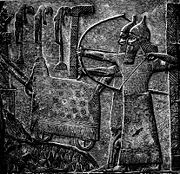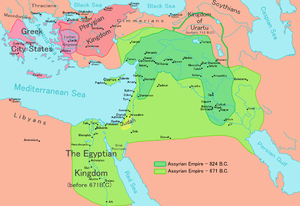
Bit-Istar
Encyclopedia
Bit-Istar was a Assyrian town and a local kingdom (c.12th cent.- c.710 BC) at western Zagros that according to inscriptions of Tiglath Pileser III and Sargon II
was located close to the source of a river to the east of Dyala.
Stronach and Calmeyer propsed Ravansar
as a possible candidate for the place of Bit-Istar.Recent surveys by Y. Hassanzadeh led to discovery of new evidence indicating presence of rich first Mil. remains close to the spring of Ravansar (34° 43′ 0″ N, 46° 40′ 0″ E).
The ruler of this town during reign of Sargon II
was Burburazu who brought his tributes to Sargon during his campaign to the region in 714 B.C. A column base at the edge of Ravansar spring could belong to a temple that was build for Ishtar near "Water hole".
Tang-i Var
, famous Assyrian inscription from reign of Sargon II is located about 30 km to north of Ravansar.


Sargon II
Sargon II was an Assyrian king. Sargon II became co-regent with Shalmaneser V in 722 BC, and became the sole ruler of the kingdom of Assyria in 722 BC after the death of Shalmaneser V. It is not clear whether he was the son of Tiglath-Pileser III or a usurper unrelated to the royal family...
was located close to the source of a river to the east of Dyala.
Stronach and Calmeyer propsed Ravansar
Ravansar
-See also:*Dekhmeh Rawansar*Khanileh*Jaff tribe*Ardalan*Javanroud*Paveh...
as a possible candidate for the place of Bit-Istar.Recent surveys by Y. Hassanzadeh led to discovery of new evidence indicating presence of rich first Mil. remains close to the spring of Ravansar (34° 43′ 0″ N, 46° 40′ 0″ E).
The ruler of this town during reign of Sargon II
Sargon II
Sargon II was an Assyrian king. Sargon II became co-regent with Shalmaneser V in 722 BC, and became the sole ruler of the kingdom of Assyria in 722 BC after the death of Shalmaneser V. It is not clear whether he was the son of Tiglath-Pileser III or a usurper unrelated to the royal family...
was Burburazu who brought his tributes to Sargon during his campaign to the region in 714 B.C. A column base at the edge of Ravansar spring could belong to a temple that was build for Ishtar near "Water hole".
Tang-i Var
Tang-i Var
Tang-i Var is a Neo-Assyrian relief with a cuneiform inscription located in a narrow gorge at south of Palangan, about 50 km southwest of the city of Sanandaj,in the Iranian Kurdistan. It was discovered by A. Sarfaraz from Archaeological Service of Iran in 1968. With the help of Iranian army he...
, famous Assyrian inscription from reign of Sargon II is located about 30 km to north of Ravansar.



